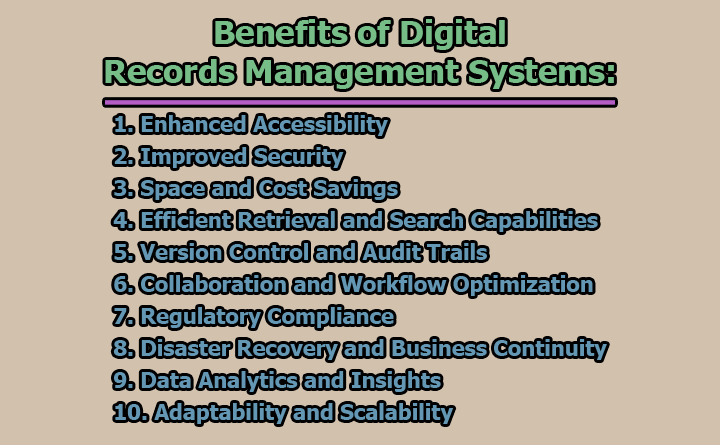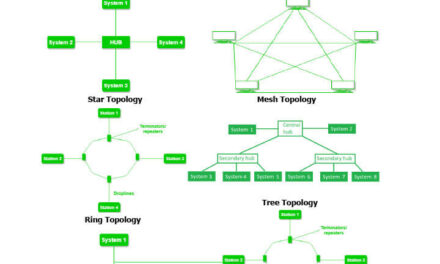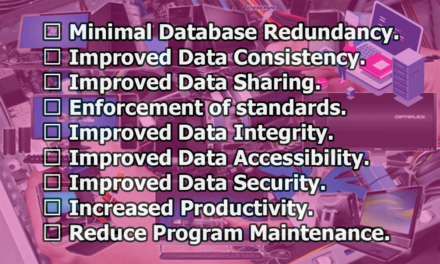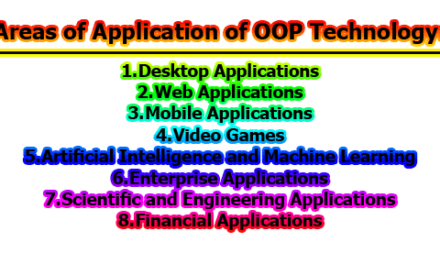Benefits of Digital Records Management Systems:
Digital Records Management Systems (DRMS) have become indispensable tools for organizations in the digital age, revolutionizing the way they handle information. As businesses transition from paper-based systems to digital platforms, the benefits of implementing DRMS are increasingly evident. In this technological era, the advantages of embracing digital records management extend beyond mere efficiency gains. Let’s explore 10 key benefits of digital records management systems.
1. Enhanced Accessibility: Digital Records Management Systems (DRMS) revolutionize the way organizations access their information. Unlike traditional paper-based systems, DRMS allow for quick and convenient retrieval of digital records from virtually anywhere. This enhanced accessibility is particularly crucial in today’s dynamic business environment where remote work and collaboration across different geographical locations are commonplace. With DRMS, authorized users can access documents in real-time, fostering seamless collaboration and expediting decision-making processes. This benefit not only improves operational efficiency but also contributes to the overall agility of the organization.
2. Improved Security: One of the paramount concerns for organizations is the security of their sensitive information. Digital Records Management Systems address this concern by offering advanced security features. Encryption protocols safeguard data during transmission and storage, protecting it from unauthorized access. Access controls further restrict permissions, ensuring that only authorized personnel can view or modify specific records. This level of security is critical in maintaining the confidentiality and integrity of sensitive information, mitigating the risks associated with data breaches and unauthorized data manipulation.
3. Space and Cost Savings: Transitioning from physical paper records to digital formats results in significant space and cost savings for organizations. Physical storage facilities, filing cabinets, and the associated real estate costs become obsolete as digital records are stored electronically. This reduction in physical infrastructure not only optimizes office space but also leads to cost savings related to maintenance, printing, and paper supplies. Furthermore, the environmental impact of reducing paper consumption aligns with sustainability goals, making DRMS a cost-effective and environmentally responsible choice for organizations.
4. Efficient Retrieval and Search Capabilities: Digital Records Management Systems offer powerful search functionalities that revolutionize the way organizations retrieve information. Manual searching through physical documents is time-consuming and prone to errors, whereas DRMS provide quick and accurate retrieval of specific records. Advanced search features, including metadata tagging and keyword search, enable users to locate information swiftly. This efficiency not only saves time but also minimizes the risk of errors associated with manual document handling, enhancing overall productivity and reducing operational bottlenecks.
5. Version Control and Audit Trails: DRMS provide robust version control features, addressing the challenges associated with managing document revisions. Organizations can track changes made to documents over time, ensuring that the most recent and accurate version is always accessible. Additionally, the system maintains detailed audit trails that record user activities, such as who accessed, modified, or deleted a document. These audit trails enhance accountability and transparency, critical factors for regulatory compliance. Version control and audit trails contribute to maintaining the integrity of records, supporting organizations in meeting legal and industry-specific compliance requirements.
6. Collaboration and Workflow Optimization: Digital Records Management Systems facilitate seamless collaboration and workflow optimization within organizations. Through integrated collaboration tools, multiple users can simultaneously access, edit, and comment on documents in real-time. This real-time collaboration eliminates the need for back-and-forth emails or physical document sharing, leading to a more efficient and streamlined workflow. Teams, whether working in the same office or remotely, can collaborate seamlessly on projects, fostering better communication and ensuring that everyone is working with the most up-to-date information.
7. Regulatory Compliance: Achieving and maintaining regulatory compliance is a critical aspect of business operations. Digital Records Management Systems play a pivotal role in helping organizations meet regulatory requirements and industry standards. The ability to track document changes, maintain version control, and establish secure audit trails ensures that organizations can demonstrate compliance with various regulations. This includes data protection laws, industry-specific standards, and other legal requirements. The comprehensive documentation and security features of DRMS provide organizations with the tools they need to navigate complex regulatory landscapes successfully.
8. Disaster Recovery and Business Continuity: Digital Records Management Systems contribute to robust disaster recovery and business continuity strategies. These systems often include automated backup solutions that ensure data is regularly backed up and can be swiftly recovered in the event of data loss, system failure, or a catastrophic event. By safeguarding critical records and information, DRMS help organizations minimize downtime and maintain essential business operations during unexpected disruptions. This proactive approach to disaster recovery enhances overall resilience, ensuring that organizations can quickly recover and resume normal activities.
9. Data Analytics and Insights: Beyond efficient record-keeping, DRMS empower organizations to derive valuable insights from their data. These systems can integrate with data analytics tools, allowing organizations to analyze trends, patterns, and key performance indicators. By leveraging the data stored in digital records, organizations can make informed decisions, identify areas for improvement, and strategize for the future. The ability to turn data into actionable insights enhances organizational intelligence and contributes to a data-driven decision-making culture.
10. Adaptability and Scalability: Digital Records Management Systems are designed to be adaptable and scalable to accommodate the evolving needs of organizations. As businesses grow and undergo changes, DRMS can easily scale to handle increased data volumes and additional users. The adaptability of these systems ensures that they remain effective and relevant in the face of changing business requirements, technological advancements, and industry trends. This scalability positions organizations to embrace growth without being hindered by limitations in their records management infrastructure.
In conclusion, the adoption of Digital Records Management Systems transcends mere digitization; it represents a strategic investment in organizational efficiency, security, and adaptability. By embracing the benefits outlined above, businesses position themselves to thrive in an increasingly digital and competitive landscape, where the effective management of information is paramount to success. As organizations navigate the complexities of the modern business environment, the implementation of DRMS emerges as a fundamental step towards sustainable growth and resilience.

Library Lecturer at Nurul Amin Degree College










